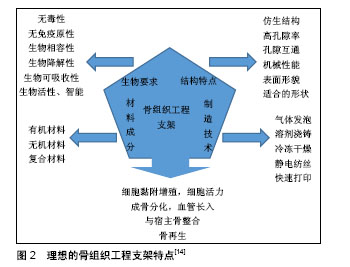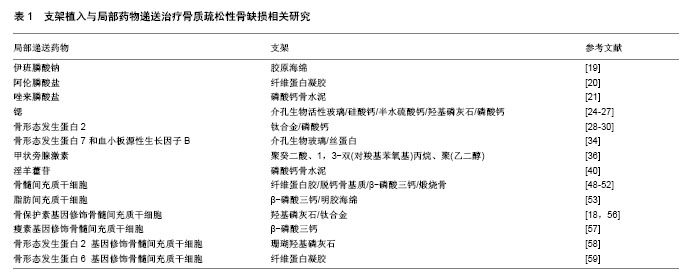| [1] Rachner TD,Khosla S,Hofbauer LC.Osteoporosis: now and the future.Lancet. 2011;37(9773):1276-1287.[2] Teitelbaum SL.Stem Cells and Osteoporosis Therapy.Cell Stem Cell.2010;7(5):553-554.[3] Hemmeler C,Morell S,Amsler F,et al.Screening for osteoporosis following non-vertebral fractures in patients aged 50 and older independently of gender or level of trauma energy-a Swiss trauma center approach.Arch Osteoporos. 2017;12(1):38.[4] Mirsaidi A,Genelin K,Vetsch JR,et al.Therapeutic potential of adipose-derived stromal cells in age-related osteoporosis. Biomaterials. 2014;35(26):7326-7335.[5] Reichert JC,Saifzadeh S,Wullschleger ME,et al.The challenge of establishing preclinical models for segmental bone defect research. Biomaterials.2009;30(12):2149-2163.[6] Egermann M,Schneider E,Evans CH,et al.The potential of gene therapy for fracture healing in osteoporosis. Osteoporosis Int. 2005; 16:S120-S128.[7] Agarwal R,Garcia AJ.Biomaterial strategies for engineering implants for enhanced osseointegration and bone repair.Adv Drug Del Rev. 2015;94(12):53-62.[8] Gruskin E,Doll BA,Futrell FW,et al.Demineralized bone matrix in bone repair: History and use.Adv Drug Del Rev. 2012;64(12):1063-1077.[9] Schilcher J,Michaelsson K,Aspenberg P.Bisphosphonate Use and Atypical Fractures of the Femoral Shaft.New Engl J Med. 2011;364(18): 1728-1737.[10] Black DM,Kelly MP,Genant HK,et al.Bisphosphonates and Fractures of the Subtrochanteric or Diaphyseal Femur.New Engl J Med. 2010;362 (19):1761-1771.[11] Ruggiero SL,Mehrotra B,Rosenberg TJ,et al.Osteonecrosis of the jaws associated with the use of bisphosphonates: A review of 63 cases.J Oral Maxil Surg.2004;62(5):527-534.[12] Bolland MJ,Avenell A,Baron JA,et al.Effect of calcium supplements on risk of myocardial infarction and cardiovascular events: meta-analysis. Bmj-Brit Med J. 2010;341(7767):289-289.[13] Liu H,Webster TJ.Ceramic/polymer nanocomposites with tunable drug delivery capability at specific disease sites.J Biomed Mater Res A. 2010;93(3):1180-1192.[14] 何春耒,王大平,马经野.骨组织工程支架材料的种类及发展趋势[J].中国组织工程研究与临床康复,2009,13(25):4905-4908.[15] 梁卫东,王宏伟,王志强.不同骨组织工程支架材料的生物安全性及性能[J].中国组织工程研究与临床康复, 2010,14(34):6385-6388.[16] 朱伟民,王大平,熊建义骨组织工程支架材料的生物学特性及临床应用[J].中国组织工程研究与临床康复, 2007,11(48):9781-9784.[17] Luhmann T,Germershaus O,Groll J,et al.Bone targeting for the treatment of osteoporosis. Journal of controlled release : official journal of the Controlled Release Society. 2012;161(2):198-213.[18] Liu X,Bao C,Xu HHK,et al.Osteoprotegerin gene-modified BMSCs with hydroxyapatite scaffold for treating critical-sized mandibular defects in ovariectomized osteoporotic rats.Acta Biomater. 2016;42:378-388.[19] Guo JL,Zhang Q,Li J,et al.Local application of an ibandronate/collagen sponge improves femoral fracture healing in ovariectomized rats.Plos One. 2017;12(11):e0187683.[20] Kim BS,Shkembi F,Lee J.In Vitro and In Vivo Evaluation of Commercially Available Fibrin Gel as a Carrier of Alendronate for Bone Tissue Engineering.Biomed Res Int. 2017;2017(3):6434169.[21] Wu CC,Wang CC,Lu DH,et al.Calcium phosphate cement delivering zoledronate decreases bone turnover rate and restores bone architecture in ovariectomized rats.Biomed Mater. 2012;7(3):035009.[22] Ray S,Thormann U,Eichelroth M,et al.Strontium and bisphosphonate coated iron foam scaffolds for osteoporotic fracture defect healing. Biomaterials.2018;157:1-16.[23] Kargozar S,Lotfibakhshaiesh N,Ai J,et al.Strontium- and cobalt-substituted bioactive glasses seeded with human umbilical cord perivascular cells to promote bone regeneration via enhanced osteogenic and angiogenic activities.Acta Biomater. 2017;58: 502-514.[24] Zhang Q,Chen XH,Geng SN,et al.Nanogel-based scaffolds fabricated for bone regeneration with mesoporous bioactive glass and strontium: In vitro and in vivo characterization. J Biomed Mater Res A. 2017; 105(4):1175-1183.[25] Lin K,Xia L,Li H,et al.Enhanced osteoporotic bone regeneration by strontium-substituted calcium silicate bioactive ceramics. Biomaterials. 2013;34(38):10028-10042.[26] Yang S,Wang L,Feng S,et al.Enhanced bone formation by strontium modified calcium sulfate hemihydrate in ovariectomized rat critical-size calvarial defects.Biomed Mater. 2017;12(3):035004.[27] Neves N,Linhares D,Costa G,et al.In vivo and clinical application of strontium-enriched biomaterials for bone regeneration: A systematic review.Bone Joint Res. 2017;6(6):366-375.[28] Sachse A,Wagner A,Keller M,et al.Osteointegration of hydroxyapatite-titanium implants coated with nonglycosylated recombinant human bone morphogenetic protein-2 (BMP-2) in aged sheep. Bone.2005;37(5):699-710.[29] Wolfle JV,Fiedler J,Durselen L,et al.Improved Anchorage of Ti6Al4V Orthopaedic Bone Implants through Oligonucleotide Mediated Immobilization of BMP-2 in Osteoporotic Rats.Plos One. 2014;9(1): e86151.[30] Huang L,Luo Z,Hu Y,et al.Enhancement of local bone remodeling in osteoporotic rabbits by biomimic multilayered structures on Ti6Al4V implants.J Biomed Mater Res A. 2016;104(6):1437-1451.[31] Li M,Liu X,Liu X,et al.Calcium phosphate cement with BMP-2-loaded gelatin microspheres enhances bone healing in osteoporosis: a pilot study.Clin Orthop Relat Res. 2010;468(7):1978-1985.[32] Kim HK,Lee JS,Kim JH,et al.Bone-forming peptide-2 derived from BMP-7 enhances osteoblast differentiation from multipotent bone marrow stromal cells and bone formation. Exp Mol Med. 2017; 49(5):e328.[33] Wang X,Huang J,Huang F,et al.Bone morphogenetic protein 9 stimulates callus formation in osteoporotic rats during fracture healing.Mol Med Rep.2017;15(5):2537-2545.[34] Zhang Y,Cheng N,Miron R,et al.Delivery of PDGF-B and BMP-7 by mesoporous bioglass/silk fibrin scaffolds for the repair of osteoporotic defects.Biomaterials. 2012;33(28):6698-6708.[35] Xie ZJ,Weng SJ,Li H,et al.Teriparatide promotes healing of critical size femur defect through accelerating angiogenesis and degradation of beta-TCP in OVX osteoporotic rat model. Biomed Pharmacother. 2017;96:960-7.[36] Dang M,Koh AJ,Jin XB,et al.Local pulsatile PTH delivery regenerates bone defects via enhanced bone remodeling in a cell-free scaffold. Biomaterials.2017;114:1-9.[37] Wang Q,Cao LY,Liu Y,et al.Evaluation of synergistic osteogenesis between icariin and BMP2 through a micro/meso hierarchical porous delivery system.Int J Nanomed. 2017;12:7721-7735.[38] Chen R,Qi QL,Wang MT,et al.Therapeutic potential of naringin: an overview.Pharm Biol. 2016;54(12):3203-3210.[39] Chen SH,Zheng LZ,Zhang JY,et al.A novel bone targeting delivery system carrying phytomolecule icaritin for prevention of steroid-associated osteonecrosis in rats.Bone. 2018;106:52-60.[40] Wu Y,Cao L,Xia L,et al.Evaluation of Osteogenesis and Angiogenesis of Icariin in Local Controlled Release and Systemic Delivery for Calvarial Defect in Ovariectomized Rats. Sci Rep. 2017;7(1):5077.[41] Clines GA.Prospects for osteoprogenitor stem cells in fracture repair and osteoporosis. Curr Opin Organ Tran. 2010;15(1):73-78.[42] Berglund AK,Fortier LA,Antczak DF,et al.Immunoprivileged no more: measuring the immunogenicity of allogeneic adult mesenchymal stem cells.Stem Cell Res ther.2017;8:288.[43] Vilquin JT,Rosset P.Mesenchymal stem cells in bone and cartilage repair: current status. Regen Med. 2006;1(4):589-604.[44] Ben-Ari A,Rivkin R,Frishman M,et al.Isolation and implantation of bone marrow-derived mesenchymal stem cells with fibrin micro beads to repair a critical-size bone defect in mice.Tissue Eng Part A. 2009; 15(9):2537-2546.[45] Langenbach F,Naujoks C,Laser A,et al.Improvement of the cell-loading efficiency of biomaterials by inoculation with stem cell-based microspheres, in osteogenesis.J Biomater Appl. 2012;26(5):549-564.[46] Pountos I,Georgouli T,Henshaw K,et al.The Effect of Bone Morphogenetic Protein-2, Bone Morphogenetic Protein-7, Parathyroid Hormone, and Platelet-Derived Growth Factor on the Proliferation and Osteogenic Differentiation of Mesenchymal Stem Cells Derived From Osteoporotic Bone.J Orthop Trauma.2010;24(9):552-556.[47] Ocarino ND,Boeloni JN,Jorgetti V,et al.Intra-bone marrow injection of mesenchymal stem cells improves the femur bone mass of osteoporotic female rats.Connect Tissue Res. 2010;51(6):426-433.[48] Orsi PR, Landim-Alvarenga FC, Justulin LA, et al. A unique heterologous fibrin sealant (HFS) as a candidate biological scaffold for mesenchymal stem cells in osteoporotic rats.Stem Cell Res Ther. 2017; 8(1):205.[49] Wang ZX,Chen C,Zhou Q,et al.The Treatment Efficacy of Bone Tissue Engineering Strategy for Repairing Segmental Bone Defects Under Osteoporotic Conditions.Tissue Eng Part A. 2015;21(17-18): 2346-2355.[50] Qi X,Zhang J,Yuan H,et al.Exosomes Secreted by Human-Induced Pluripotent Stem Cell-Derived Mesenchymal Stem Cells Repair Critical-Sized Bone Defects through Enhanced Angiogenesis and Osteogenesis in Osteoporotic Rats.Int J Biol sci.2016;12(7):836-849.[51] Cao L,Liu GW,Gan YK,et al.The use of autologous enriched bone marrow MSCs to enhance osteoporotic bone defect repair in long-term estrogen deficient goats.Biomaterials. 2012;33(20):5076-5084.[52] Liu YH,Min LG,Luo HL,et al.Integration of a calcined bovine bone and BMSC-sheet 3D scaffold and the promotion of bone regeneration in large defects.Biomaterials. 2013;34(38):9998-10006.[53] Ye X,Zhang P,Xue S,et al.Adipose-derived stem cells alleviate osteoporosis by enhancing osteogenesis and inhibiting adipogenesis in a rabbit model.Cytotherapy. 2014;16(12):1643-1655.[54] Kikuta S,Tanaka N,Kazama T,et al.Osteogenic effects of dedifferentiated fat cell transplantation in rabbit models of bone defect and ovariectomy-induced osteoporosis.Tissue Eng Part A. 2013;19 (15-16):1792-1802.[55] Kearns AE,Khosla S,Kostenuik PJ.Receptor activator of nuclear factor kappaB ligand and osteoprotegerin regulation of bone remodeling in health and disease.Endocr Rev. 2008;29(2):155-192.[56] Yin G,Chen J,Wei S,et al.Adenoviral vectormediated overexpression of osteoprotegerin accelerates osteointegration of titanium implants in ovariectomized rats.Gene Ther.2015;22(8):636-664.[57] Zheng B,Jiang J,Chen Y,et al.Leptin Overexpression in Bone Marrow Stromal Cells Promotes Periodontal Regeneration in a Rat Model of Osteoporosis.J Periodontol. 2017;88(8):808-818.[58] Tang Y,Tang W,Lin Y,et al.Combination of bone tissue engineering and BMP-2 gene transfection promotes bone healing in osteoporotic rats. Cell Biol Int. 2008;32(9):1150-1157.[59] Pelled G,Sheyn D,Tawackoli W,et al.BMP6-Engineered MSCs Induce Vertebral Bone Repair in a Pig Model: A Pilot Study. Stem Cells Int. 2016;2016:6530624.[60] Boldrini C,de Almeida JM,et al.Biomechanical effect of one session of low-level laser on the bone-titanium implant interface.Laser Med Sci. 2013;28(1):349-352.[61] de Vasconcellos LM,Barbara MA,Rovai ES,et al.Titanium scaffold osteogenesis in healthy and osteoporotic rats is improved by the use of low-level laser therapy (GaAlAs). Laser Med Sci. 2016;31(5): 899-905.[62] Jia P,Chen H,Kang H,et al.Deferoxamine released from poly(lactic-co-glycolic acid) promotes healing of osteoporotic bone defect via enhanced angiogenesis and osteogenesis.J Biomed Mater Res A.2016;104(10):2515-2527.[63] Cheng N,Wang Y,Zhang Y,et al.The osteogenic potential of mesoporous bioglasses/silk and non-mesoporous bioglasses/silk scaffolds in ovariectomized rats: in vitro and in vivo evaluation.Plos One.2013;8(11):e81014.[64] Wu T,Cheng N,Xu C,et al.The effect of mesoporous bioglass on osteogenesis and adipogenesis of osteoporotic BMSCs.J Biomed Mater Res A.2016;104(12):3004-3014. |
.jpg)



.jpg)
.jpg)